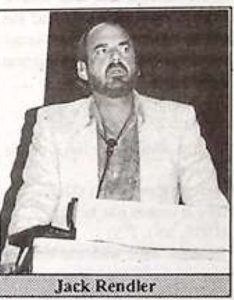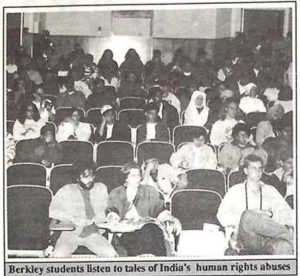
BERKELEY: A large and interested audience gathered Tuesday Nov.17 to hear Amnesty International campaign director Jack Rendler Immigration Autormey Jon Melrod and two Sikhs who were themselves victims of India’s State sponsored repression tell of the continuing Saja of custody deaths routine encounter killings and the epidemic of rape and torture that is rampant in India. Rendler chronigled the history of Amnesty’s interest and involvement in the rights of Indian Citizens. “Torture and deaths in custody through India’s 25 states are the prominent concern of Amnesty today.” Since 1963 when Amnesty took its first case they have followed up with reports on India’s Human Rights abuses at the rate of two per year since 1974. One of the main issues is India’s use of preventive and arbitrary detention “TADA” under which thousands are held. India’s press reported that there were 15000 political prisoners detained in Kashmir alone Not only do the prisoners suffer but each one has a family and a village that suffers because of their arrest. India has a political system that is built on its capacity to cause injury and suffering. The use of “TADA” since 1985 has seen normal judicial practices suspended. The use of “Disappearances” and “faked encounters” in especially prevalent in Punjab and Kashmir. This is repression without responsibility.
Amnesty doesn’t distinguish between the abuses of civilians by the government and by opposition groups. Condemning the torture hostage taking and the killings of innocent family members by all groups is the Amnesty role.
Often regarded as a Police state the Indian government is adept at custodial violence which includes the torture rape and death of those arrested. Fifty cases per year have met Amnesty International’s strict but conservative reporting system. But Amnesty International is aware that the true total is much higher.
Regardless of the political party in power torture is routinely practiced.
The U.N. has made it clear that the rape of women in custody is torture and sometimes against it. The police and security forces have victims from babies to grandmothers. Most often rape is used to humiliate and intimidate the women and their families Often people are tortured in an attempt to extract a confession or obtain intelligence information.
“It is the responsibility of the government to bring this under control yet it is obvious that the federal government condones and supports torture.” Amnesty is not saying anything new to those concerned with this issue commented Mr.Rendler.
The 1992 Amnesty report lists 415 individuals who have died in custody but the total is certainly larger. Only three cases have been investigated and no officials have been brought to justice Amnesty therefor concludes that the government of India must approve of torture unto death as a way of controlling the population.
Yet Amnesty International can record some progress over the past year.
The issue was debated in the Press.
Government set up a Human Rights commission (supposedly with power to investigate reports).
Amnesty International just completed its first mission since 1974 (although it was restricted).
We have seen the collaboration of jurists Civil Liberties groups and some police organizations.
Reopening of court cases investigating custody killings.
But the litmus test will be if those who are guilty are brought to justice.
Attorney Jon Melrod gave examples of the cases that have been brought to his office and individuals who have been granted asylum because of the obvious horrors that they have undergone.
Devinder Singh and Harminder Singh Somana both all India Sikh Student Federation (AISSF) members told a horrid story of their torture. They were picked up several times by Punjab police tortured and kept in custody without any charges. After their release they fled to the U.S. to seek political asylum.
A question and answers period followed which allowed students to learn more about the Sikhs struggle for human rights. Outside the hall photos of the victims of the state sponsored repression were a graphic reminder of the horrors that had been discussed.
Great credit to Amandeep Kaur of Sikh Studies Association and Salma Khan of Muslim Student Union for their efforts to enlighten the public of the ongoing situation.


Article extracted from this publication >> December 4, 1992